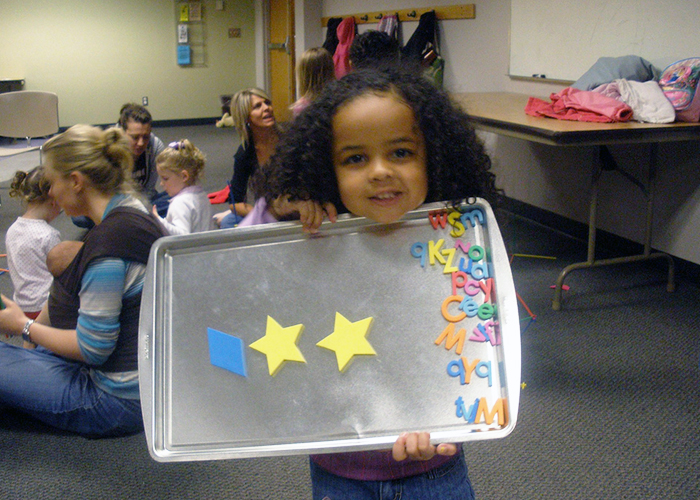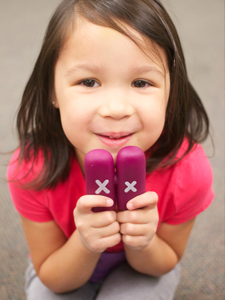Literacy
 Starting kindergarten involves many big transitions. One transition that takes place is kids begin to take early literacy skills, what they know about reading and writing before they can actually read and write, and start turning them into literacy skills. The more early literacy skills your child has developed, the better prepared they will be when it is time for them to learn how to read and write. Many early literacy skills are developed naturally when you spend time talking, singing, reading, writing, and playing with your child. However, as kids get closer to kindergarten, it can be helpful to practice some more advanced literacy skills. Don’t worry though, these activities will still feel like playtime!
Starting kindergarten involves many big transitions. One transition that takes place is kids begin to take early literacy skills, what they know about reading and writing before they can actually read and write, and start turning them into literacy skills. The more early literacy skills your child has developed, the better prepared they will be when it is time for them to learn how to read and write. Many early literacy skills are developed naturally when you spend time talking, singing, reading, writing, and playing with your child. However, as kids get closer to kindergarten, it can be helpful to practice some more advanced literacy skills. Don’t worry though, these activities will still feel like playtime!
Activities to try at home
DIY Door sign
“I Spy” rhyming game
Special delivery
Rhyme time
Letter of the day
DIY alphabet book
Letter sounds
Tell me a story
DIY door sign
Help your child learn the letters of his or her name by making a sign for the bedroom door. There are tons of fun ways to make your own door signs. One simple way is to use foam letters or find letters in magazines that you cut out for your child to use. You can also cut out your own foam or paper letters. Help your child choose (or make) the letters of their name, and then either string the letters together or glue them onto a piece of paper. Your child can decorate their sign (crayons, glitter, stickers, and so on) before hanging it on the door.
“I Spy” rhyming game
Play “I Spy” using rhyming pairs. For example, if you see a tree, then you can tell your child, “I spy something that rhymes with bee.” Once your child guesses what you see (sometimes additional hints are needed), take turns letting your child pick what is seen and give the clue as a rhyme. Rhyming games help kids begin to hear that words are made up of smaller sounds put together.
Special delivery
Create a mailbox out of a shoebox. Help your child write letters to members of your family. Let your child draw a picture and/or write letters anyway he or she can. Even if your child isn’t writing actual letters, scribbling is a pre-writing stage. Your child can also dictate what he or she wants to say in the letter to you while you write it down. Then put the letters in the mailbox so family members can check for mail later that day. You can also help your child write a letter to a family member or friend who doesn’t live near you, and take a fun outing to the post office to mail it. Everybody loves to get mail!
Rhyme time
Rhyming games help your child begin to identify the different sounds within words. One great thing about rhyming games is that they are easy to take on the road. If you’re driving in the car, waiting at the doctor’s office, or anywhere else your kid needs some entertainment, take turns picking a beginning word and then work together to think of as many words as you can that rhyme with that word. Your child may use made up words, such as rhyming “gat” with “cat,” and that is ok, it still rhymes and they are understanding the important concept of listening to different sounds within the word.
Letter of the day
Your child has most likely already learned their shapes, such as heart, square, and triangle. Learning the shapes and names of letters builds on this knowledge. At the beginning of the day, pick a letter. Have your child describe its shape and trace it with their finger. Then, have a scavenger hunt and see how many places you can find that letter throughout the day. If your child hasn’t learned their name yet, starting with the letters of their name adds some extra interest.
DIY alphabet book
Alphabet books are a great way to introduce and learn the letters of the alphabet. Making your own alphabet book takes that learning one step further and creates a fun, tactile art project your child can be proud of. There are several ways to do this. You can make up all of the letter pages to begin with and then decorate them over time, or you can make one page at a time until you have all 26 pages completed. Start by writing the letter on the page and then have your child practice writing the letter as well. Then help your child decorate the book by cutting out magazine pictures to paste in or drawing items that begin with that letter on the page. It can be especially fun to add pictures of family and friends to their appropriate letter page.
Letter sounds
Put letters of the alphabet in a box (empty tissue box works great). These can be magnetic letters or you can make your own with card stock or cardboard. Shake up the box and then let your child pick out a letter. Name the letter, practice its sound, and then name words that start with that letter. Shake and repeat!
Tell me a story
Create props for a favorite story and then let your child retell the story with you. You can create a felt board story, use stuffed animals and dolls, or cut pictures out of a magazine. There are so many fun ways to make props. If your child is particularly into being dramatic, you can even dress up and act it out! This fun game gives your child a chance to practice narrative skills, which is the ability to describe things and events and tell stories.

